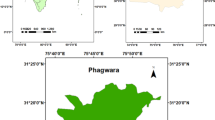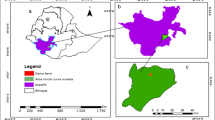Abstract
This study mathematically correlates the infiltration rate of vegetated soil with time and demonstrates how to estimate the amount of infiltration in any type of vegetated soil without conducting a field experiment. Vetiver (Vetiveria zizanioides) was planted in two plots: one with cohesive soil and one with cohesionless soil. The infiltration was measured under field conditions for 26 weeks, using the double-ring infiltrometer method. Sixteen analytical equations were carefully chosen to empirically correlate the infiltration rate with time, using the field data; 4 of the 16 were taken from the currently available empirical infiltration equations. The models’ performances were evaluated, based on four statistical parameters: sum of squares due to errors (SSE), R-square, adjusted R-square, and root-mean-square error (RMSE). The accuracy of each equation was determined by the number of times it ranked first for a single week, as well as its cumulative ranking, based on the statistical parameters. The equations’ sensitivity to the seasons, age of vegetation, and soil type were analyzed, and it was revealed that E3 performed the best of all of the equations. Occasions where other equations outperformed E3 were critically examined, based on the E3 coefficient values, and their performances were validated by data from another study. It was concluded that the performance of the equations may show sensitivity to the type of vegetation, geographic location, and climatic condition.








Similar content being viewed by others
Data availability
The datasets generated and/or analyzed by the current study are available from the corresponding author upon reasonable request.
Abbreviations
- ANFIS:
-
Adaptive neuro-fuzzy inference system
- ANN:
-
Artificial neural network
- ASTM:
-
American Society for Testing and Materials
- BS:
-
Bare soil
- FCR:
-
Flux–concentration relation
- FM:
-
Fineness modulus
- NOT:
-
Number of terms
- RMSE:
-
Root-mean-square error
- SL No.:
-
Serial number
- SSE:
-
Sum of squares due to error
- TCA:
-
Time condensation approximation
- USCS:
-
Unified soil classification system
- USDA:
-
United States Department of Agriculture
- VS:
-
Vegetated soil
- C c :
-
Coefficient of curvature
- C u :
-
Coefficient of uniformity
- D 50 :
-
Median diameter
- i :
-
Infiltration rate
- i o :
-
Initial infiltration rate
- i f :
-
Stable infiltration rate
- N :
-
Number of times an equation was ranked as the best
- t :
-
Time
References
Alam T, Barua S, Anisa H, Islam MS (2019) Evaluation of infiltration rate from soil properties using artificial neural network. In: International conference on disaster risk manage (ICDRM), Dhaka, Bangladesh.
Assouline S, Selker JS, Parlange JY (2007) A simple accurate method to predict time of ponding under variable intensity rainfall. Water Resour Res 43:W03426. https://doi.org/10.1029/2006WR005138
ASTM C136, C136M-19 (2019) Standard test method for sieve analysis of fine and coarse aggregates. ASTM Int, West Conshohocken
ASTM D3385-03 (2003) Standard test method for infiltration rate of soils in field using double-ring infiltrometer. ASTM Int, West Conshohocken
Bashar MA (2000) Geotechnical characterization of Dhaka metropolitan area. M.Sc Thesis, Bangladesh University of Engineering and Technology (BUET), Dhaka, Bangladesh
Bi Y, Zou H, Zhu C (2014) Dynamic monitoring of soil bulk density and infiltration rate during coal mining in sandy land with different vegetation. Int J Coal Sci Technol 1(2):198–206. https://doi.org/10.1007/s40789-014-0025-2
Broadbridge P, White I (1987) Time to ponding: comparison of analytic, quasi-analytic and approximate predictions. Water Resour Res 23(12):2302–2310
Chowdhury ME, Islam MA, Islam T, Khan N (2018) Evaluation of shear strength of cohesionless soil from maximum, minimum dry density and fines content using polynomial surface fitting method. Electron J Geotech Eng 23(1):31–56
De Almeida WS, Panachuki E, de Oliveira PT, da Silva Menezes R, Sobrinho TA, de Carvalho DF (2017) Effect of soil tillage and vegetal cover on soil water infiltration. Soil Tillage Res 175:130–138. https://doi.org/10.1016/j.still.2017.07.009
Erskine J (1992) Vetiver grass: its potential use in soil and moisture conservation in Southern Africa. S Afr J Sci 88(6):298–299
Gavin K, Xue J (2008) A simple method to analyze infiltration into unsaturated soil slopes. Comput Geotech 35:223–230
Green WH, Ampt GA (1911) Studies on soil phyics, 1. The flow of air and water through soils. J Agric Sci 4:1–24
Haghighi F, Saghafian B, Kheirkhah M (2011) Evaluation of soil hydraulic parameters in soils and land use change. INTECH Open Access Publ, London
Hellin J, Haigh M (2002) Better land husbandry in Honduras: towards the new paradigm in conserving soil, water and productivity. Land Deg Dev 13:233–250
Hengchaovanich D (1999) Vetiver grass for slope stabilization and erosion control. Bangkok, Thailand: Tech. Bull. No. 1998/2, PRVN/ORDPB
Horton RE (1933) The role of infiltration in the hydrological cycle. Trans Am Geophys Union 14:446–460
Hossain A, Chowdhury ME, Islam MS (2019) Evaluation of the effect of rainfall on slope stability analysis by using hydraulic unit flux infiltration property. In: International conference on disaster risk manage (ICDRM), Dhaka, Bangladesh
Islam MS (2003) Role of vetiver in controlling wate R-borne erosion with particular reference to Bangladesh coastal region. In: Third international conference on Vet Exhib, Guangzhou, China
Islam MS, Arifuzzaman, Nasrin S (2010) In-situ shear strength of vetiver grass rooted soil. In: Bangladesh Geotechnical conference on natural hazards countermeasures in geotechnical engineering, Dhaka, Bangladesh, pp 274–279
Islam MS, Badhon FF (2020) A mathematical model for shear strength prediction of vetiver rooted soil. ASCE, Minneapolis. https://doi.org/10.1061/9780784482797.010
Islam MS, Arifuzzaman Shahin HM, Nasrin S (2013) Effectiveness of vetiver root in embankment slope protection: Bangladesh perspective. Int J Geotech Eng 7(2):136–148
Islam MS, Arif MZU, Badhon FF, Mallick S, Islam T (2016a) Investigation of vetiver root growth in sandy soil. In: BUET-ANWAR ISPAT 1st Bangladesh Civil Engineering Summit, Dhaka, Bangladesh
Islam MS, Hoque MS, Mallick S, Parshi FN, Rahman AKML (2016b) Climate resilient slope protection for coastal regions of Bangladesh using bioengineering techniques. In: 3rd International Conference on Advances in Civil Engineering, Chattogram, Bangladesh
Islam MA, Islam MS, Elahi TE (2020) Effectiveness of vetiver grass on stabilizing hill slopes: a numerical approach. ASCE, Minneapolis. https://doi.org/10.1061/9780784482797.011
Kostiakov AN (1932) On the dynamics of the coefficient of water percolation in soils and on the necessity of studying it from a dynamic point of view for purposes of amelioration. Trans Sixth Comm Int Soc Soil Sci Part A (Moscow) 14:17–21
Kumar M, Sihag P (2019) Assessment of infiltration rate of soil using empirical and machine learning-based models. Irrig Drain. https://doi.org/10.1002/ird.2332
Lewis MR (1937) The rate of infiltration of water in irrigation practice. Trans Am Geophys Union 18:361–368
Mein RG, Larson CL (1973) Modelling infiltration during a steady rain. Water Resour Res 9(2):384–394
Meyer L, Dabney S, Harmon W (1995) Sediment trapping effectiveness of stiff-grass hedges. Trans ASAE 38(3):809–815
Mickovski S, van Beek L, Salin F (2005) Uprooting of vetiver uprooting resistance of vetiver grass (Vetiveria zizanioides). Plant Soil 278:33–41
Mishra SK, Tyagi JV, Singh VP (2003) Comparison of infltration models. Hydrol Process 17(13):2629–2652
Paulescu M, Stefu N, Calinoiu D, Paulescu E, Pop N, Boata R, Mares O (2016) Ångström-Prescott equation: physical basis, empirical models and sensitivity analysis. Renew Sustain Energy Rev 62:495–506
Philip JR (1957) The theory of infiltration sorptivity and algebraic infiltration equations. Soil Sci 84:257–264
Philip JR (1969) Theory of infiltration. Adv Hydrosci 5:215–296
Rawls WJ, Brakensiek DL, Miller N (1983) Green-ampt infiltration parameters from soils data. J Hydraul Eng 109:62–70
Salam M, Abdul Shehana R, Mammen M, Kunjamma P (1993) Rooting pattern of vetiver (Vetiveria zizanioides (L.) nash) in an oxisol. Trop Agric 70(3):274–275
Sepahvand A, Sihag P, Singh B, Zand M (2018) Comparative evaluation of infiltration models. KSCE J Civil Eng. https://doi.org/10.1007/s12205-018-1347-1
Sihag P, Tiwari NK, Ranjan S (2017a) Prediction of unsaturated hydraulic conductivity using adaptive neuro-fuzzy inference system (ANFIS). ISH J Hydraul Eng. https://doi.org/10.1080/09715010.2017.1381861
Sihag P, Tiwari NK, Ranjan S (2017b) Modelling of infltration of sandy soil using gaussian process. Model Earth Syst Environ 3:1091–1100. https://doi.org/10.1007/s40808-017-0357-1
Sihag P, Tiwari NK, Ranjan S (2018) Prediction of cumulative infiltration of sandy soil using random forest approach. J Appl Water Eng Res. https://doi.org/10.1080/23249676.2018.1497557
Simunek J, Saito H, Sakai M, Genuchten TM (2008) The HYDRUS-1D software package for simulating the one-dimensional movement of water, heat, and multiple solutes in variably-saturated media. University of California, Riverside, p 68
Singh B, Sihag P, Singh K (2017) Modelling of impact of water quality on infiltration rate of soil by random forest regression. Model Earth Syst Environ 3:999–1004. https://doi.org/10.1007/s40808-017-0347-3
Singh B, Sihag P, Deswal S (2019a) Modelling of the impact of water quality on the infiltration rate of the soil. Appl Water Sci. https://doi.org/10.1007/s13201-019-0892-1
Singh B, Sihag P, Pandhiani SM, Debnath S, Gautam S (2019b) Estimation of permeability of soil using easy measured soil parameters: assessing the artificial intelligence-based models. ISH J Hydraul Eng. https://doi.org/10.1080/09715010.2019.1574615
Sivapalan M, Milly P (1989) On the relationship between the time condensation approximation and the flux-concentration relation. J Hydrol 105:357–367
Smith RE (1972) The infiltration envelope: results from a theoretical infiltrometer. J Hydrol 17(1–2):1–22
Truong PN (1999) Vetiver grass technology for land stabilisation, erosion and sediment control in the Asia Pacific region. In: First Asia Pacific Conference on ground water bioeng eros control slope stab 72–84. Manila, Philippines: Int Eros Control Assoc, Steamboat Springs, USA
Truong P, Loch R (2004) Vetiver system for erosion and sediment control. In: 13th International Soil Conservation Organisation Conference 1–6. Brisbane, Australia
Vogel T, van Genuchten MT, Cislerova M (2001) Effect of the shape of the soil hydraulic functions near saturation on variably-saturated flow predictions. Adv Water Res 24:133–144
Wang J, Chen L, Yu Z (2017) Modelling rainfall infiltration on hillslopes using flux-concentration relation and time compression approximation. J Hydrol. https://doi.org/10.1016/j.jhydrol.2017.12.031
Funding
This research was supported by the Academic Research Grant of the Bangladesh University of Engineering and Technology (BUET).
Author information
Authors and Affiliations
Corresponding author
Ethics declarations
Conflict of interest
The authors certify that they have no affiliations with or involvement in any organization or entity with any financial or non-financial interest in the subject matter or materials discussed in this manuscript.
Code availability
No custom or new code was used in this paper.
Additional information
Publisher's Note
Springer Nature remains neutral with regard to jurisdictional claims in published maps and institutional affiliations.
Appendix A. Statistical parameters
Appendix A. Statistical parameters
See Table 6.
Rights and permissions
About this article
Cite this article
Chowdhury, M.E., Islam, M.S., Alam, T. et al. Infiltration in vegetated soil: empirical modeling and sensitivity analysis. Model. Earth Syst. Environ. 7, 547–559 (2021). https://doi.org/10.1007/s40808-020-00867-x
Received:
Accepted:
Published:
Issue Date:
DOI: https://doi.org/10.1007/s40808-020-00867-x




